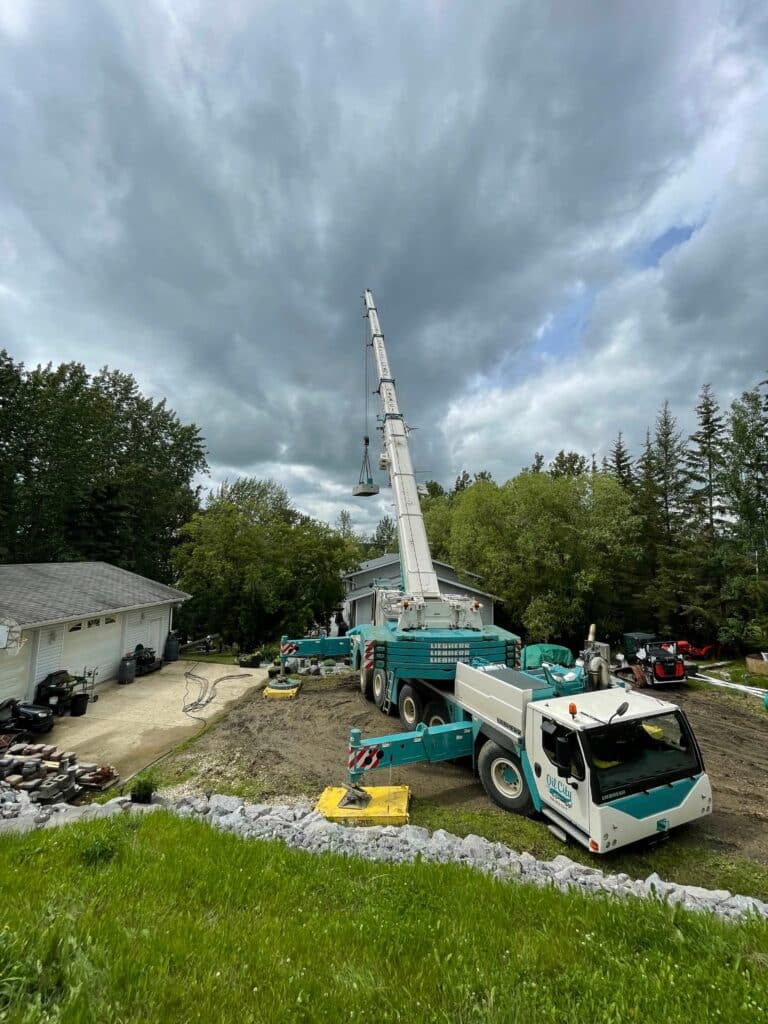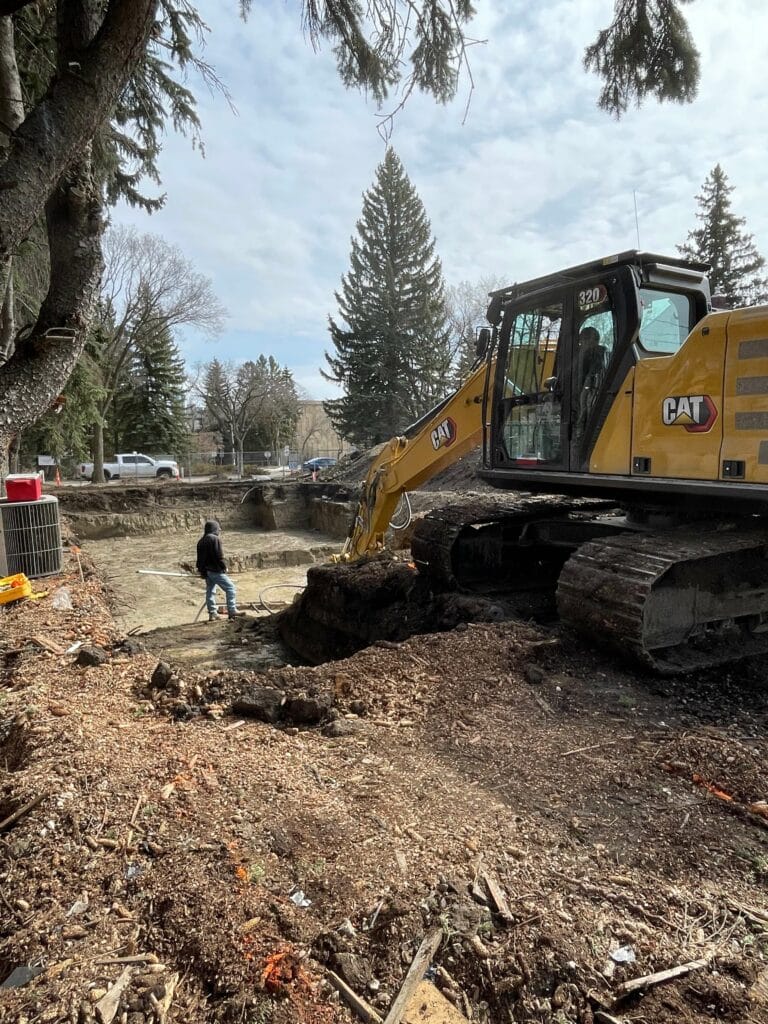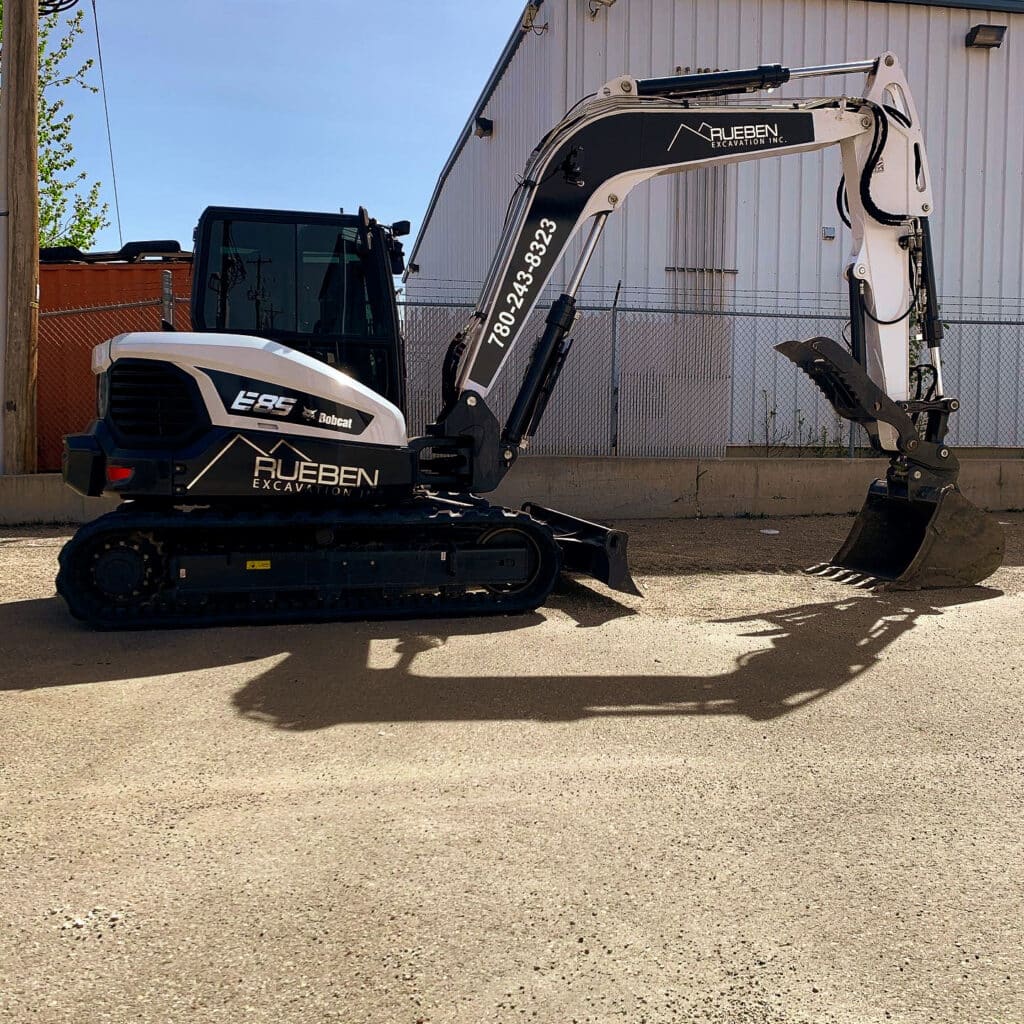A culvert is a pipe installed in the ground, used typically to allow water to flow underneath a driveway or roadway.
That would depend on if you already have an existing culvert that you would like to replace, then you would not need one. If the culvert is on private property and not adjacent to a public roadway then you would not need one. If the culvert is adjacent to a public roadway and you are not replacing one that is existing, you would need to contact your county in order to get permission to install one. The process is a simple form to fill out, if you meet the requirements then you are permitted to proceed as long as you adhere to their construction standards which they will outline for you.
Generally speaking, in order to prepare the ground for a concrete slab the first step is to remove all the organic material such as sod and topsoil, it is preferable to excavate down to clay. In order to create a proper base a minimum of 6 inches of compacted Flex Base should be installed under the slab so you must take into account the thickness of the slab plus the 6 inches of flex base and excavate to the desired depth. If you have not removed all the organic material at this point it is best to continue excavation and then build up with select fill or flex base to the desired elevation. The flex base must be installed in layers and properly compacted with a plate tamper or roller.
First things first you are going to need to decide what kind of pond you want on your property, weather it is a swimming pond, pond for fish, or to water animals or simply just to act as a water feature. The purpose of the pond will have a lot to do with determining the size, shape and depth. Once you know these things the next step is to find a suitable place on the property and then dig a test hole to see what type of soil you have. When it comes to ponds clay is your friend. You want to avoid sandy soil, rocky soil or clay with too much sand in it as these soil types will not hold water. You are looking for good solid clay, otherwise you may find yourself with a giant hole in the ground that will require a liner in order to hold water.
In the city of Dallas, the process for demolishing a house is as follows; firstly, you as the homeowner will need to apply for a Master permit for demolition, the city will need to know who is completing the demolition. You should have the home tested for hazardous materials such as asbestos. Once this is completed and a demolition contractor has been retained the next step is to apply for a utility disconnect, a permit is required in order to have the power and gas disconnected from the property. At this point the home is ready to be demolished. It is a great idea to contact a non-profit organization such as habitat for humanity and allow them to remove any items of value such as doors, hardware and kitchens from the home to be sold or used, doing so can also reduce your tax liability. Once the home has been stripped of valuables the demolition contractor will generally use an excavator to tear the home down, forcing all the debris into the basement with the machine and then loading all the debris out into garbage bins to be hauled away to the landfill to be sorted and disposed of. Once completed the lot can be prepared for the new construction project.
A septic holding tank can be commonly found on older properties or on properties that are restricted on space which would be unable to house a septic field otherwise known as a leach field. Alternatively, if the ground has a very high water table and inadequate drainage a holding tank may be the only option available to service your needs. A holding tank is a very basic way of containing sewage and wastewater and has been used for decades. It is simply as it sounds, a tank placed in the ground to hold the septic waste discharge from a property. Typically, in newer systems these tanks will either be plastic, fiberglass or concrete and are available in many different sizes, shapes and configurations. The main downside of holding tanks are that the require you to regularly pay a septic truck to empty your tank, typically every two months.
A septic leach field is a series of perforated pipes buried 2-4 feet below the surface of the ground. The leach field will be connected downstream of a septic tank to allow the treated effluent to drain into the field and slowly leach into the ground. The perforated pipes are generally laid on top of a bed of clear stone or sand to allow for good drainage and then covered with the native soil to allow for grass to be grown on top of the field area.
The answer to this is very dependent on your needs and a professional should be consulted to choose the right tank for your application however I will explain the different types of tanks available. In newer systems concrete, plastic, or fiberglass are the products of choice and offer pros and cons to each, fiberglass tanks tend to be the most inexpensive however they offer the least amount of structural integrity and are unable to be buried more than 36 inches in the ground and once buried you are unable to place any heavy objects on top of them such as a ride on lawn mower or any vehicles as this can cause the tank to collapse. Plastic tanks offer a little more in the form of structural integrity and can be buried up to 6 feet in the ground, you are still unable to pass overtop of them with anything more than foot traffic however it does give you the option of burying them deeper which potentially allows you the ability to have a basement bathroom or drain point. The main thing to keep in mind is the top of the septic tank has to be buried lower than the lowest plumbing fixture in the house in order for this fixture to drain via gravity. It is possible to pump sewage up into a tank however this requires more things to add to the system and in turn more costs and more possibilities for things to fail, repair and maintain over the lifespan. Concrete tanks are able to be buried at deeper depths and also have a higher structural integrity to them, it is still not advisable to drive over them however there is much less risk of a collapse in the event that someone does. That being said concrete tanks are generally more expensive and require larger equipment and better access in order to install them.
Historically, there was only one type of septic system, and it consisted of a septic tank and a leechfield. This type of system is now called a ‘standard’ or ‘conventional system.’ As information has improved about how soil structure reacts to wastewater, the septic system industry has improved too, and the technology has evolved to treat wastewater more effectively. This is great news, not only for the sake of improved technology and reliability for consumers (you!), but because our groundwater resources are now much better protected from contamination.
There are many types of septic systems, with a conventional or standard septic system being the least complicated kind. The other most common types of OSSFs are:
-Aerobic Systems with Spray irrigation
-Aerobic system with drip irrigation
-low pressure dosing (LPD system)
These models are more complex than the standard system and need more maintenance, but they may be necessary to treat wastewater properly. The type of system you need for your own property depends on the properties of the soil and the regulations set by the Texas Commission of Environmental Quality (TCEQ).
An on-site sewage facility or septic system, disposes of wastewater on-site. All of the wastewater must seep into the soil on the property and not rise to the surface of the ground or discharge into a roadside ditch or stream or gully. Since all systems do not use septic tanks to treat wastewater, these systems are called on-site sewage facilities (OSSF).
If your property is not within reach of a public sewer line and if your project will generate wastewater, then the answer is yes. A building equipped with bathrooms, sinks, kitchens, washing machines, etc., will generate wastewater. Older properties with inadequate or malfunctioning facilities are required to have a new facility installed or the existing facility upgraded.
If you live in an older home it is a good idea to have have a camera inspection done on your line at least once every year in order to detect any issues prior to them becoming major problems. Before you purchase a new home, you should have a camera inspection on the sewer line.
Typical signs a line needs to be replaced are sewage backups, slow draining of your sinks and other fixtures. Sometimes there are no signs at all. It is always recommended to have an inspection done prior to a problem arising to determine the condition of your line. This is a quick and inexpensive thing to do and will give you peace of mind or at the very least warn you of any potential issues.
First thing you would want to do is solve the current problem. You should start with a drain cleaning company or plumber, if you are having a problem contact us and we can arrange this. Next you will want to contact your home insurance to arrange cleanup. And then you will want to find out what the problem is and correct it, the drain cleaning or plumbing company will be able to tell you what the problem is.
Pipe bursting is a method that can be used to replace a sewer line. The process is simple in theory, an access pit is dug either in your basement or outside your home to reach the sewage line. Another pit is excavated at the city connection point for your home. The existing pipe is then cut and removed at each end. A steel cable is then fed into the pipe from one end and a coned cutting head is then pulled through the old line with a hydraulic puller. The steel cable is then re-fed through the old pipe where a larger head is then attached. On the other side of this head the new seamless plastic pipe is attached and then it is all pulled into place at once. Once pulled though the old line the new pipe is connected on both ends, the holes are backfilled, and you are now up and running with a new sewer line.
There is no one answer fits all, it is always dependent on the condition of your existing line and the number of obstacles present on your property. If your existing line runs under a structure such as a deck or garage of expensive landscaping then pipe bursting will generally be the best option. If your line does not run under any structures then it depends on the condition of your existing line. If you have any long sags in the line or if it is already collapsed then pipe bursting may not be the best option, even though it is less invasive it is not always the best method to replace your sewer line.
Generally, for most residential lines it is a 2-day process from start to finish. You can expect to be without water and sewer services for 4-5 hours total from start to finish.
There are different grades and types of pipe used to replace a sewer line, polyethylene pipe is generally what is used. When pipe bursting, we use HDPE (high density polyethylene pipe) this is preferred because it can be fused together to make a seamless pipe as long as is required. When doing open excavation, we recommend SDR-35 poly pipe it is typically green, PVC schedule 40 pipe can also be used. SDR-35 is more flexible and the joints have rubber seals to avoid leaks during movement. Schedule 40 pvc is glued together however if the ground shifts the connections can crack and leak, we prefer these products over HDPE when doing open excavation as it is more rigid and much easier to ensure a constant 1 percent slope when installing the line. There are many different products available for use however we choose to only use the best quality and highest grade available to us as this should be a repair that lasts the lifetime of your home.
Yes, you need a permit in order to replace a sewer line in the state of Texas, In some cases small repairs may be completed without one however most work will require a permit in order to be properly completed.
In Dallas underground utilities need to be installed by a bonded utility contractor, or in some cases a master plumber is able to pull a permit in order to install them. If you need more information, we would be happy to answer any questions you may have.
Electrical duct banks are an important part of a site’s underground infrastructure and are precast concrete conduits that protect underground electrical power lines and other important underground cabling. In a duct bank, data and electrical cables are laid out within PVC conduits that are bundled together.
By installing an electrical duct bank, a landowner, in the future, can then add additional underground power lines and other cabling without having to re-dig the original trench when there underground cabling or power lines were laid. New power lines can then be fed through the duct bank at any time in the future, and continue to be completely protected, which is a better solution than just burying electrical wires.
If you are planning future development on property that you own or lease, and you are unsure as to how much power or wiring that site might require in the future, then you may want to consider installing an underground electrical duct bank. Electrical duct banks help landowners by making future construction projects easier and simpler since you don’t have to re-excavate the entire trench when adding new underground power lines or cabling and may enhance the value of the property in the future.
The installation of electrical duct banks is also common in projects where you need to install cabling underneath roads, parking lots and other areas that have existing structures.
A duct bank is two or more ducts or conduits used as a part of a system. A duct bank is designed to protect and group or consolidate data and electrical cables to and from a building.
Soil moisture conditioning refers to the process of preparing the soil for construction of a structure or slab. This is achieved by either reducing or increasing the moisture content of the soil to a pre-determined level in order to prevent unstable soil conditions from developing below the structure.
The process to moisture condition soil in North Texas is relatively simple although it is not overly easy, the area to be conditioned is over excavated down to the required depth the excavated material is then saturated with water until the desired moisture content is reached at which point it is re-installed and compacted in lifts in its original position, once completed the soil is typically covered with poly and then capped with 12 inches of either select fill or flex base.




